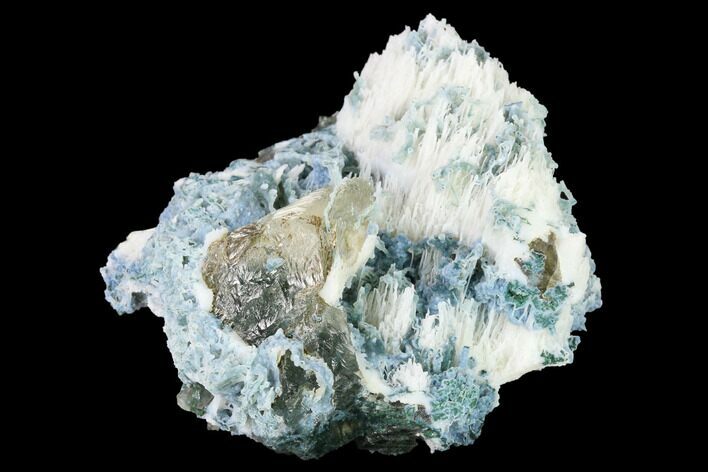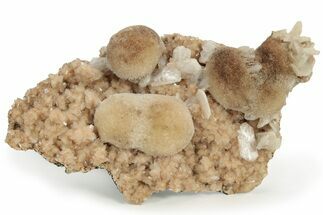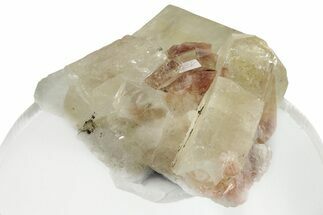This Specimen has been sold.
2.8" Blue and White Chalcedony "Strings" with Calcite - India
This is an unusual, 2.8" wide specimen of blue and white chalcedony "strings", collected from Maharashtra, India. The blue chalcedony strings formed over an unidentified green mineral that likely hung from the ceiling of the cavity that this specimen was collected from. There is a calcite crystal protruding through the blue chalcedony strings. These blue chalcedony specimens are often associated with mordenite
sprays.
It comes with an acrylic display stand.
sprays.
It comes with an acrylic display stand.
Chalcedony is any microcrystalline variety of silica composed of very fine intergrowths of quartz and mogánite: microcrystalline minerals have microscopic crystals that cannot be observed by the naked eye. Both quartz and mogánite have the same chemical formula SiO2 (silicon dioxide), but different crystal structures. When free from impurities, chalcedony is colorless and transparent. Depending on impurities present during formation, chalcedony can form in a wide variety of colors including red, yellow, green, blue, purple, grey, white, and numerous hues in between. Chalcedony is quite hard at 7 on the Mohs Hardness Scale: this matches its main component quartz, which is the benchmark mineral for the scale at 7.
About Quartz
Quartz is the name given to silicon dioxide (SiO2) and is the second most abundant mineral in the Earth's crust. Quartz crystals generally grow in silica-rich environments--usually igneous rocks or hydrothermal environments like geothermal waters--at temperatures between 100°C and 450°C, and usually under very high pressure. In either case, crystals will precipitate as temperatures cool, just as ice gradually forms when water freezes. Quartz veins are formed when open fissures are filled with hot water during the closing stages of mountain formation: these veins can be hundreds of millions of years old.
Quartz is the name given to silicon dioxide (SiO2) and is the second most abundant mineral in the Earth's crust. Quartz crystals generally grow in silica-rich environments--usually igneous rocks or hydrothermal environments like geothermal waters--at temperatures between 100°C and 450°C, and usually under very high pressure. In either case, crystals will precipitate as temperatures cool, just as ice gradually forms when water freezes. Quartz veins are formed when open fissures are filled with hot water during the closing stages of mountain formation: these veins can be hundreds of millions of years old.
About Calcite Crystals
Calcite crystals are a form of calcium carbonate (CaCO₃) known for their diverse shapes, transparency, and vibrant range of colors. They typically form in rhombohedral, scalenohedral, or prismatic shapes, often with well-defined, sharp edges and glossy surfaces. Calcite crystals are often translucent or transparent, sometimes displaying a double refraction effect where objects viewed through the crystal appear doubled. They can appear in various colors—white, clear, yellow, pink, blue, green, and orange—depending on impurities or trace minerals.
A notable characteristic of calcite is its reaction with weak acids like vinegar, which causes it to effervesce, or fizz, as it releases carbon dioxide. This property makes calcite crystals a key tool in geological identification and studies. Calcite forms in many environments, from sedimentary rocks like limestone and marble to hydrothermal veins.
Calcite crystals are a form of calcium carbonate (CaCO₃) known for their diverse shapes, transparency, and vibrant range of colors. They typically form in rhombohedral, scalenohedral, or prismatic shapes, often with well-defined, sharp edges and glossy surfaces. Calcite crystals are often translucent or transparent, sometimes displaying a double refraction effect where objects viewed through the crystal appear doubled. They can appear in various colors—white, clear, yellow, pink, blue, green, and orange—depending on impurities or trace minerals.
A notable characteristic of calcite is its reaction with weak acids like vinegar, which causes it to effervesce, or fizz, as it releases carbon dioxide. This property makes calcite crystals a key tool in geological identification and studies. Calcite forms in many environments, from sedimentary rocks like limestone and marble to hydrothermal veins.
SPECIES
Quartz var. Chalcedony & Calcite
LOCATION
Maharashtra, India
SIZE
2.8 x 2.4"
CATEGORY
ITEM
#168843
 Reviews
Reviews















